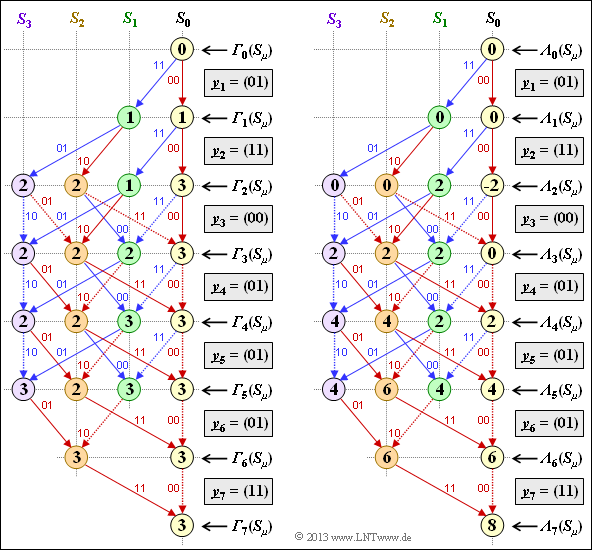Difference between revisions of "Aufgaben:Exercise 3.10: Metric Calculation"
| Line 2: | Line 2: | ||
[[File:P_ID2681__KC_A_3_10.png|right|frame|Only partially evaluated trellis]] | [[File:P_ID2681__KC_A_3_10.png|right|frame|Only partially evaluated trellis]] | ||
| − | In the [[Channel_Coding/Decoding_of_Convolutional_Codes#Preliminary_remarks_on_the_following_decoding_examples| "theory section"]] of this chapter, the calculation of the branch metrics ${\it \Gamma}_i(S_{\mu})$ has been discussed in detail, based on the Hamming distance $d_{\rm H}(\underline{x}\hspace{0.05cm}', \ \underline{y}_i)$ between the possible | + | In the [[Channel_Coding/Decoding_of_Convolutional_Codes#Preliminary_remarks_on_the_following_decoding_examples| "theory section"]] of this chapter, the calculation of the branch metrics ${\it \Gamma}_i(S_{\mu})$ has been discussed in detail, based on the Hamming distance $d_{\rm H}(\underline{x}\hspace{0.05cm}', \ \underline{y}_i)$ between the possible code words $\underline{x}\hspace{0.05cm}' ∈ \{00, \, 01, \, 10, \, 11\}$ and the 2–bit–words $\underline{y}_i$ received at time $i$ is based. |
The exercise deals exactly with this topic. In the adjacent graph | The exercise deals exactly with this topic. In the adjacent graph | ||
Revision as of 21:10, 1 November 2022
In the "theory section" of this chapter, the calculation of the branch metrics ${\it \Gamma}_i(S_{\mu})$ has been discussed in detail, based on the Hamming distance $d_{\rm H}(\underline{x}\hspace{0.05cm}', \ \underline{y}_i)$ between the possible code words $\underline{x}\hspace{0.05cm}' ∈ \{00, \, 01, \, 10, \, 11\}$ and the 2–bit–words $\underline{y}_i$ received at time $i$ is based.
The exercise deals exactly with this topic. In the adjacent graph
- the considered trellis is shown– valid for the code with rate $R = 1/2$, memory $m = 2$ and $\mathbf{G}(D) = (1 + D + D^2, \ 1 + D^2)$,
- are the received words $\underline{y}_1 = (01), \hspace{0.05cm}\text{ ...} \hspace{0.05cm} , \ \underline{y}_7 = (11)$ indicated in the rectangles,
- are all branch metrics ${\it \Gamma}_0(S_{\mu}), \hspace{0.05cm}\text{ ...} \hspace{0.05cm} , \ {\it \Gamma}_4(S_{\mu})$ already entered.
For example, the branch metric ${\it \Gamma}_4(S_0)$ with $\underline{y}_4 = (01)$ as the minimum of the two comparison values
- ${\it \Gamma}_3(S_0) + d_{\rm H}((00), \ (01)) = 3 + 1 = 4$, and
- ${\it \Gamma}_3(S_2) + d_{\rm H}((11), \ (01)) = 2 + 1 = 3$.
The surviving branch – here from ${\it \Gamma}_3(S_2)$ to ${\it \Gamma}_4(S_0)$ – is drawn solid, the eliminated branch from ${\it \Gamma}_3(S_0)$ to ${\it \Gamma}_4(S_0)$ dotted. Red arrows represent the information bit $u_i = 0$, blue arrows $u_i = 1$.
In the subtask (4) the relationship between
- the ${\it \Gamma}_i(S_{\mu})$ minimization and
- the ${\it \Lambda}_i(S_{\mu})$ maximization.
shall be worked out. Here, we refer to the nodes ${\it \Lambda}_i(S_{\mu})$ as metrics, where the metric increment over the predecessor nodes results from the correlation value $〈\underline{x}_i\hspace{0.05cm}', \, \underline{y}_i 〉$ . For more details on this topic, see the following theory pages:
- "Relationship between Hamming distance and correlation"
- "Viterbi algorithm based on correlation and metrics"
- "Viterbi decision for non–terminated convolutional codes".
Hints:
- The exercise refers to the chapter "Decoding Convolutional Codes".
- For the time being, the search of surviving paths is not considered. This will be dealt with for the same example in the later "Exercise 3.11".
Questions
Solution
- $${\it \Gamma}_5(S_0) \hspace{-0.15cm} \ = \ \hspace{-0.15cm}{\rm min} \left [{\it \Gamma}_{4}(S_0) + d_{\rm H} \big ((00)\hspace{0.05cm},\hspace{0.05cm} (01) \big )\hspace{0.05cm},\hspace{0.2cm}{\it \Gamma}_{4}(S_2) + d_{\rm H} \big ((11)\hspace{0.05cm},\hspace{0.05cm} (01) \big ) \right ] ={\rm min} \left [ 3+1\hspace{0.05cm},\hspace{0.05cm} 2+1 \right ] \hspace{0.15cm}\underline{= 3}\hspace{0.05cm},$$
- $${\it \Gamma}_5(S_1) \hspace{-0.15cm} \ = \ \hspace{-0.15cm}{\rm min} \left [{\it \Gamma}_{4}(S_0) + d_{\rm H} \big ((11)\hspace{0.05cm},\hspace{0.05cm} (01) \big )\hspace{0.05cm},\hspace{0.2cm}{\it \Gamma}_{4}(S_2) + d_{\rm H} \big ((00)\hspace{0.05cm},\hspace{0.05cm} (01) \big ) \right ] ={\rm min} \left [ 3+1\hspace{0.05cm},\hspace{0.05cm} 2+1 \right ] \hspace{0.15cm}\underline{= 3}\hspace{0.05cm},$$
- $${\it \Gamma}_5(S_2) \hspace{-0.15cm} \ = \ \hspace{-0.15cm}{\rm min} \left [{\it \Gamma}_{4}(S_1) + d_{\rm H} \big ((10)\hspace{0.05cm},\hspace{0.05cm} (01) \big )\hspace{0.05cm},\hspace{0.2cm}{\it \Gamma}_{4}(S_3) + d_{\rm H} \big ((01)\hspace{0.05cm},\hspace{0.05cm} (01) \big ) \right ] = {\rm min} \left [ 3+2\hspace{0.05cm},\hspace{0.05cm} 2+0 \right ] \hspace{0.15cm}\underline{= 2}\hspace{0.05cm},$$
- $${\it \Gamma}_5(S_3) \hspace{-0.15cm} \ = \ \hspace{-0.15cm}{\rm min} \left [{\it \Gamma}_{4}(S_1) + d_{\rm H} \big ((01)\hspace{0.05cm},\hspace{0.05cm} (01) \big )\hspace{0.05cm},\hspace{0.2cm}{\it \Gamma}_{4}(S_3) + d_{\rm H} \big ((10)\hspace{0.05cm},\hspace{0.05cm} (01) \big ) \right ] ={\rm min} \left [ 3+0\hspace{0.05cm},\hspace{0.05cm} 2+2 \right ] \hspace{0.15cm}\underline{= 3}\hspace{0.05cm}.$$
The left graph shows the final evaluated ${\it \Gamma}_i(S_{\mu})$ trellis.
(2) At time $i = 6$ the termination is already effective and there are only two branch metrics left. For these one obtains with $\underline{y}_6 = (01)$:
- $${\it \Gamma}_6(S_0) \hspace{-0.15cm} \ = \ \hspace{-0.15cm}{\rm min} \left [{\it \Gamma}_{5}(S_0) + d_{\rm H} \big ((00)\hspace{0.05cm},\hspace{0.05cm} (01) \big )\hspace{0.05cm},\hspace{0.2cm}{\it \Gamma}_{5}(S_2) + d_{\rm H} \big ((11)\hspace{0.05cm},\hspace{0.05cm} (01) \big ) \right ] ={\rm min} \left [ 3+1\hspace{0.05cm},\hspace{0.05cm} 2+1 \right ] \hspace{0.15cm}\underline{= 3}\hspace{0.05cm},$$
- $${\it \Gamma}_6(S_2) \hspace{-0.15cm} \ = \ \hspace{-0.15cm}{\rm min} \left [{\it \Gamma}_{5}(S_1) + d_{\rm H} \big ((10)\hspace{0.05cm},\hspace{0.05cm} (01) \big )\hspace{0.05cm},\hspace{0.2cm}{\it \Gamma}_{5}(S_3) + d_{\rm H} \big ((01)\hspace{0.05cm},\hspace{0.05cm} (01) \big ) \right ] ={\rm min} \left [ 3+2\hspace{0.05cm},\hspace{0.05cm} 3+0 \right ] \hspace{0.15cm}\underline{= 3}\hspace{0.05cm}.$$
(3) The final value results to
- $${\it \Gamma}_7(S_0) \hspace{-0.15cm} \ = \ \hspace{-0.15cm}{\rm min} \left [{\it \Gamma}_{6}(S_0) + d_{\rm H} \big ((00)\hspace{0.05cm},\hspace{0.05cm} (11) \big )\hspace{0.05cm},\hspace{0.2cm}{\it \Gamma}_{6}(S_2) + d_{\rm H} \big ((11)\hspace{0.05cm},\hspace{0.05cm} (11) \big ) \right ] ={\rm min} \left [ 3+2\hspace{0.05cm},\hspace{0.05cm} 3+0 \right ] \hspace{0.15cm}\underline{= 3}\hspace{0.05cm}.$$
In the BSC model, one can infer from ${\it \Gamma}_7(S_{\mu}) = 3$ that three transmission errors occurred ⇒ solutions 1 and 3.
(4) Correct are statements 1 and 2:
- Maximizing the branch metrics ${\it \Lambda}_i(S_{\mu})$ according to the right sketch in the above graph gives the same result as minimizing the branch metrics ${\it \Gamma}_i(S_{\mu})$ shown on the left. Also, the surviving and deleted branches are identical in both graphs.
- The given equation is also correct, which is shown here only on the example $i = 7$:
- $${\it \Lambda}_7(S_0)) = 2 \cdot \big [i - {\it \Gamma}_7(S_0) \big ] = 2 \cdot \big [7 - 3 \big ] \hspace{0.15cm}\underline{= 8}\hspace{0.05cm}.$$
- The last statement is false. Rather applies $〈x_i', \, y_i〉 ∈ \{–2, \, 0, \, +2\}$.
Hints: In "Exercise 3.11", path finding is demonstrable for the same example, assuming ${\it \Lambda}_i(S_{\mu})$–metrics as shown in the right graph.

